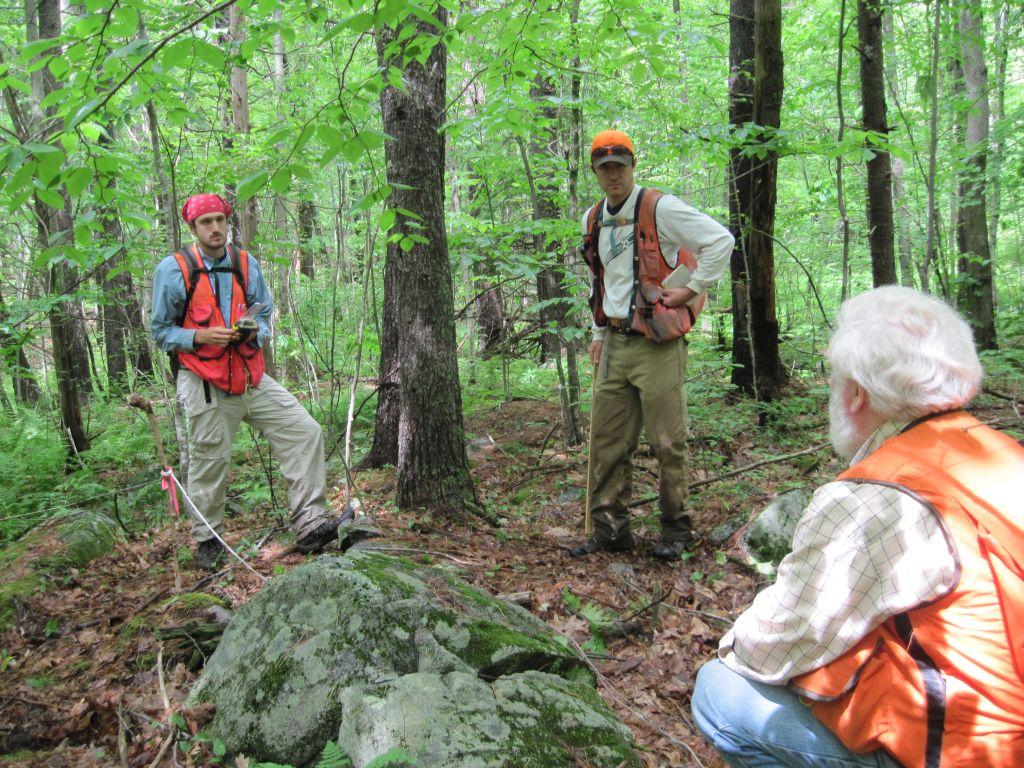- Tags:
- Working Forests,
- Stewardship

Foresters Gabe Roxby and Steve Junkin talk with George Frame during inventory. Photo by W. Weisiger
The Society of American Foresters held their annual convention in Spokane Washington last October. Always an interesting and educational event, this year's conference was entitled Resilient Forests. For my part, I picked up some rather useful information that relates directly with our current inventory and planning effort. One presentation I attended was provided by researchers at Michigan Tech, building on previous work done in the mid-west and south.
One of the things field foresters always bemoan is that researchers complete all kinds of experiments that serve little purpose in the field. The folks at Michigan did a great job at moving research data out of the laboratory. Their aim is to provide a new strategy for foresters who write silvicultural prescriptions. Silviculture is the art and science of growing trees. You might think that's pretty easy in New Hampshire, after all, trees are cut down and in some amount of time new ones grow back! How hard can that be?
Foresters, as silviculturalists, work to analyze existing resource attributes that include, current tree species occupying a site, the soils underlying that site, the topography, characteristics of the understory vegetation, general tree health, growth rates, etc., and then they prescribe a set of treatments to be applied over a period of time that will result in a desired future set of outcomes. These prescriptions are what management plans are based on.
Foresters, as planners, talk about looking well out into the future when they talk about prescriptions. But one of our basic assumptions, even when we all know the world is forever changing, is that the climate will be the same in 25, 50 , or 100 years. Will it be the same? If we accept that it won’t, shouldn’t we be making some educated guesses about how changes in climate can change what we think our outcomes will be? The researchers at Michigan think we should. But there are big questions to answer along the way. What will the climate be like and how will that climate affect the trees we are growing, the products we can expect to harvest, and the conditions that will certainly impact regeneration of our forest? Forests will need to be resilient and adaptable. How can we plan that resilience into the forest of the future when working with the forest of today?
Natural systems like forests have three options for responding to climate change or any other significant environmental shift. These options are best stated as Adapt (or Evolve), Migrate, or Die. Now we know we don't want the forest to die and migration for tree species is likely to take a very long time, so that leaves us to explore the adapt or evolve option. Michigan Tech thinks foresters can help forests transition into the different world of the future. This is why they are working to create something called adaptive silvicultural planning, and I think it is exciting and as nearly cutting edge as forestry can be.
The specifics of adaptive planning are only now trickling out to practitioners. Preliminary review shows some to be very easy to incorporate, for instance; the forests of New Hampshire contain species that overlap the southern oak-hickory type and the mixed northern hardwood type. If we believe that the future site conditions in New Hampshire will be drier than currently exist then whatever we do to favor the southern species in our long term planning will help create forests that are better adapted to the site.
Earlier this year the Forest Society hired two foresters to help us with inventory and planning. They are cruising our forestlands collecting information that is then turned into management plans with the help of the other professionals in the office. This current activity positions the Forest Society to begin using these new adaptive principles as they develop. If we are successful in learning and applying these new techniques, and are truly planning for future conditions, we will begin growing forests that will have a much better chance of surviving whatever the world climate throws at them.
Building in resilience will be somewhat more than what we are already trying to do. We hope it will allow us to positively affect forest adaptation into this uncertain future so forests carry forward the capacity to absorb insect and disease attacks, produce healthy regeneration, and continue to provide humans with the broad range of goods and services we have become dependent on over these past millennia.
